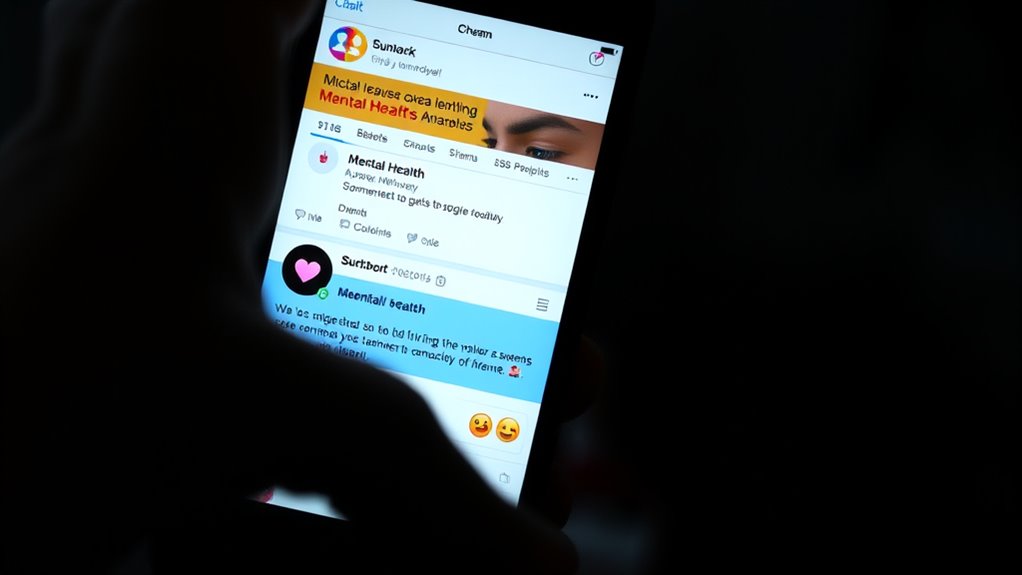Mental health features on social platforms can offer helpful support, like mood tracking and anonymous reporting, but their effectiveness really varies. When designed well and paired with strong privacy safeguards, they can promote awareness and provide quick relief. However, if privacy concerns or superficial tools hinder engagement, their impact drops markedly. To truly benefit, these features need to be thoughtfully implemented, and understanding their limitations is key—there’s more to uncover if you keep exploring.
Key Takeaways
- Effectiveness varies; consistent use and high-quality content can provide temporary relief but may lack long-term impact.
- Privacy concerns and data security issues influence user trust and engagement with mental health features.
- Design choices, like ease of access and normalization, increase user participation and potential benefits.
- Features often offer superficial support and are not substitutes for professional mental health care.
- Overall impact depends on implementation quality, user motivation, and addressing privacy to build trust.

Social platforms are increasingly integrating mental health features to support users’ well-being, recognizing the impact of online interactions on mental health. As these features become more common, you might wonder how effective they really are and whether they genuinely help or just serve as superficial fixes. One major concern that often comes up is privacy. When platforms introduce tools like mood trackers, anonymous reporting, or self-assessment quizzes, you may worry about how your data is handled. Are your feelings and personal information stored securely? Could this data be misused or leaked? These privacy concerns can make you hesitant to fully engage with mental health features, defeating their purpose altogether. If you don’t trust that your information is protected, you might avoid using these tools, which diminishes their potential benefits.
Despite these privacy worries, many platforms claim their mental health features are designed with user safety in mind. But the question remains: are these features effective? It’s one thing to add a button for mental health resources or a prompt encouraging self-care, but it’s another to see real improvements in your mental well-being. Some studies suggest that these features can be helpful when used consistently, providing immediate support or directing you to professional help. However, others argue that their impact is often superficial, offering quick fixes rather than meaningful assistance. For example, a pop-up reminder to take a break might temporarily ease stress, but it won’t address underlying issues like depression or anxiety. The effectiveness varies depending on how the features are implemented and whether users are motivated to utilize them genuinely. Additionally, the key components of sound design, such as ambient sounds and sound effects, can be used to create environments that promote relaxation and mental calmness, further enhancing mental health resources.
Furthermore, the success of mental health features depends heavily on user engagement. If platforms make these tools easily accessible and normalize their use, you’re more likely to incorporate them into your routine. But if these features are hidden behind multiple menus or presented as optional add-ons, their impact diminishes. Additionally, the quality of content matters; generic advice or superficial prompts won’t replace professional help. When platforms invest in evidence-based resources and tailor features to individual needs, they tend to be more effective. Still, it’s essential to recognize that these tools are not replacements for therapy or medical intervention—they’re supplemental.
Ultimately, whether mental health features on social platforms work for you depends on multiple factors: your trust in privacy protections, the quality of the tools, and your willingness to engage with them meaningfully. While many platforms are making strides to support your mental health, ongoing questions about privacy concerns and feature effectiveness highlight the importance of approaching these tools with a critical eye. They can be helpful, but they’re not a one-size-fits-all solution, and your awareness of their limitations can help you make better choices about how to use them.
Frequently Asked Questions
How Do Users Perceive the Effectiveness of Mental Health Features?
You might feel that mental health features on social platforms can be hit or miss, depending on your experience. Many users perceive these features as helpful if they actively engage with them, fostering a sense of support and awareness. However, some may see limited effectiveness due to lack of visibility or understanding. Your engagement and honest feature perceptions influence how well these tools serve your mental health needs, shaping their overall impact.
Are There Privacy Concerns With Mental Health Tools on Social Platforms?
Imagine your sensitive mental health data as a fragile glass, easily shattered if mishandled. Yes, privacy concerns exist with these tools, especially around data privacy and how your information is shared. You might worry about who accesses your details, risking your trust. Social platforms must prioritize safeguarding your data to build and maintain your trust. Without transparency and security, your confidence in these features could weaken, leaving you hesitant to share openly.
What Metrics Are Used to Measure Mental Health Feature Success?
You measure success through engagement metrics like active user interactions, time spent on mental health features, and feedback. Track feature adoption rates to see how many users utilize these tools regularly. Monitoring changes in user-reported well-being and reductions in distress signals can also indicate effectiveness. By analyzing these metrics, you can determine whether your mental health features are making a positive impact and identify areas for improvement.
How Accessible Are These Features for Diverse User Populations?
You’ll find that mental health features’ accessibility varies across diverse user populations. Language barriers often limit understanding and use, especially for non-native speakers. Additionally, cultural sensitivity is vital; features designed without considering different cultural contexts may not resonate or be effective. To truly support everyone, social platforms need to incorporate multilingual options and culturally aware designs, ensuring these tools are accessible and meaningful for all users, regardless of background.
Do Mental Health Features Reduce Stigma Associated With Mental Health Issues?
Yes, mental health features can reduce stigma through increased awareness campaigns, encouraging open conversations. When you see platforms promoting mental health resources and sharing personal stories, you’re more likely to feel understood and less isolated. These features normalize mental health discussions, helping to break down stereotypes. By actively engaging with these tools, you contribute to stigma reduction and foster a more supportive environment for everyone.
Conclusion
You might be surprised to learn that over 60% of users report feeling more supported when social platforms include mental health features. These tools can make a real difference in reducing stigma and encouraging open conversations. While they’re not perfect, they show promise in helping you manage mental health better. Keep in mind, your online community can be a valuable resource — so don’t hesitate to use these features to support your well-being.










